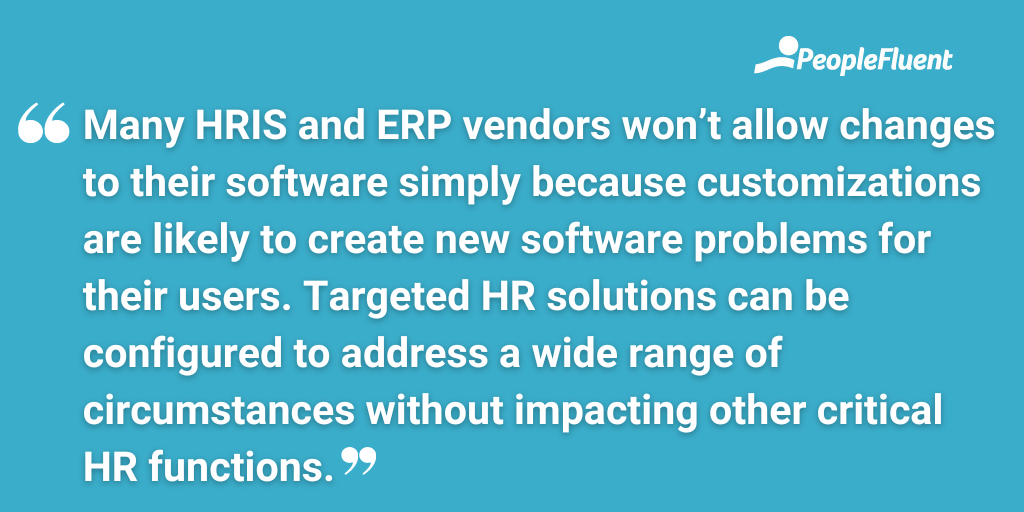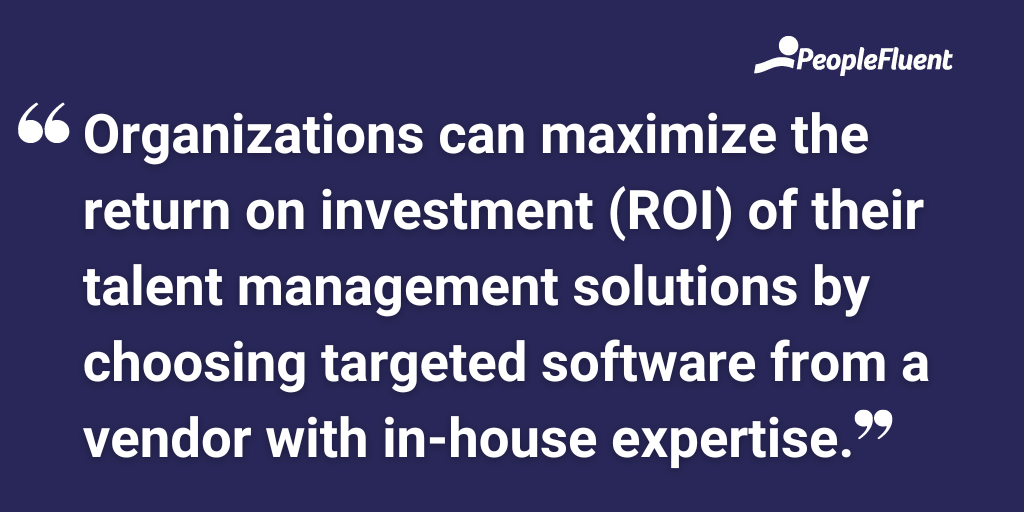Published: Jan 25, 2024Time to read: 6mins Category: Insights
4 Hidden Pitfalls of an All-in-One HR Solution
Opting for a monolithic human resource information system (HRIS) or enterprise resource planning (ERP) platform instead of targeted HR solutions doesn’t always fit an organization’s unique business needs. In this blog post, learn about four common drawbacks to implementing an all-in-one HR solution.
All-in-one HR solutions often boast integrated modules for performance management, succession planning, learning management, and more. They promise a holistic and streamlined talent management experience under a single software umbrella. An HRIS includes basic functions to keep track of employee data and assist with core HR responsibilities, such as talent acquisition and compensation management. ERP solutions are similar in that they include core HR functionalities, but these solutions are also used to manage other business processes like procurement, supply chain, manufacturing, and more. Both systems can manage basic HR functions, but an all-in-one HR solution isn’t always the best option for meeting your organization’s specific business needs.
The more complex an organization’s processes are, the more likely it is that they’ll require very specific features that aren’t widely available within all-in-one solutions. Before choosing HR software, CHROs and talent leaders must consider their organization’s pain points, specific circumstances, and the tools they need to address their unique situations. An all-in-one system might include features that are unnecessary for your company, leading to steeper learning curves and potential inefficiencies for your users. Another consideration is how updating or modifying all-in-one solutions—or even changing one module within the system—can potentially impact your entire software, making customization difficult and posing additional challenges.
Complex and enterprise organizations with intricate needs benefit from targeted, or “best of breed”, HR solutions. All-in-one systems can be the right choice for some companies, but it’s important to be aware of the following four pitfalls.
1) Limited Functionality
When companies choose an all-in-one talent solution, they’re often choosing to limit the capabilities of their HR departments. An HRIS or ERP system might perform basic functions related to compensation, performance, and succession planning, but these systems often lack the depth and detailed functionality and reporting capabilities that targeted software can provide.
For example, many all-in-one HRIS solutions cannot create multiple additional budget pools with granular separation. This can cause problems for complex organizations with multiple business units allocating their budgets in different ways. When the various budget pools and calculations are rolled up into one overall budget for the organization, company leaders aren’t able to see how much is truly being spent in each pool when looking at the overall budget summary. The lack of granular separation also means leaders can’t easily tell whether specific business units are adhering to their budgets. Software specifically dedicated to compensation planning can typically be configured to account for these and other complex scenarios, ensuring that organizations have the detailed information needed to make informed decisions.

READ MORE ABOUT TARGETED COMPENSATION SOFTWARE | ‘5 Ways PeopleFluent Addresses Compensation Gaps in Human Resource Solutions’
2) Lack of Configuration
Enterprise organizations have complex needs that can require very specific or custom solutions. An HRIS or ERP system wouldn’t always be the best choice for these organizations since the solutions are often limited in terms of customization or configurability. Company-specific configuration is usually limited to a few basic areas like colors, logos, and fonts. Specific rules, notifications, or even management privileges often can’t be changed for individual customers.
The lack of flexibility is because the backend of the software is highly interconnected, and a small change to one module can “break” functionality elsewhere in the system. Many HRIS and ERP vendors won’t allow changes to their software simply because customer-specific configurations are likely to create new software problems for their users.
Targeted HR solutions, on the other hand, can be configured to address a wide range of circumstances without negatively impacting other critical HR functions. These solutions can also be integrated with an organization’s existing HRIS, meaning that the organization can pull employee data from their current reporting system into the point solution and get the specific configurations needed to resolve their pain points.
For example, a company with multiple business units operating in both North America and Asia might use two distinct HRISs to manage their employee data. The HRISs manage their performance planning well, but the company needs more robust compensation planning capabilities. A targeted compensation software can pull employee data from both the North American and Asian HRIS without disrupting the company’s current processes. With the right configurations, the compensation software can then provide granular compensation reporting for each of the organization’s business units in both world regions.
3) Hidden Costs
Despite providing access to basic HR functions, there’s no guarantee that all-in-one solutions will meet every organizational need. All-in-one HR solutions often have gaps in their functionalities, and bridging those gaps can be costly. If your HR team discovers that the HRIS or ERP system lacks a key capability, then you will have to invest in additional technology to meet its needs. On top of the extra technology, many times vendors will charge a fee to integrate the new tool with the existing HRIS. Choosing targeted talent solutions from the start ensures that you have the specific functionalities you need to accomplish your goals without paying more for configurations or system integrations.

KEEP READING ABOUT TARGETED HR SOLUTIONS | ‘How Performance Software Can Transform Your Employee Skills and Competency Management’
4) Lack of Expert Support
All-in-one HRIS and ERP system vendors generally don’t specialize in specific business processes. Their products cover the basics of so many business areas that it’s unfeasible for them to offer in-house expert support. As organizations continue to grow, their HR strategies will also evolve, and vendors of all-in-one solutions likely won’t be able to offer the expert-level support that these companies need to achieve their advancing goals.
Another reason why these vendors don’t have in-house expertise is that they often outsource their product implementations. When you want to update your software configurations to continue to align with evolving business strategy, your HRIS or ERP vendor will likely advise you to seek out a consultant to help you achieve your goals. This means you need to devote time and resources to finding the right consultant for your needs, not to mention the added costs of hiring a third party to fix your software problems.
Organizations can maximize the return on investment (ROI) of their talent management solutions by choosing targeted software from a vendor with in-house expertise. Because specialist vendors like PeopleFluent offer highly customizable and configurable solutions that manage specific HR processes, they often have in-house experts who are ready to help their clients optimize the software and strategize to achieve business goals.
Choose Targeted Solutions That Help You Reach Your Business Goals
Whether you want to optimize your performance strategy or you need granular compensation data, PeopleFluent offers a targeted HR solution to meet your needs. Request a product demo or contact us to see how we can help reach your business goals.